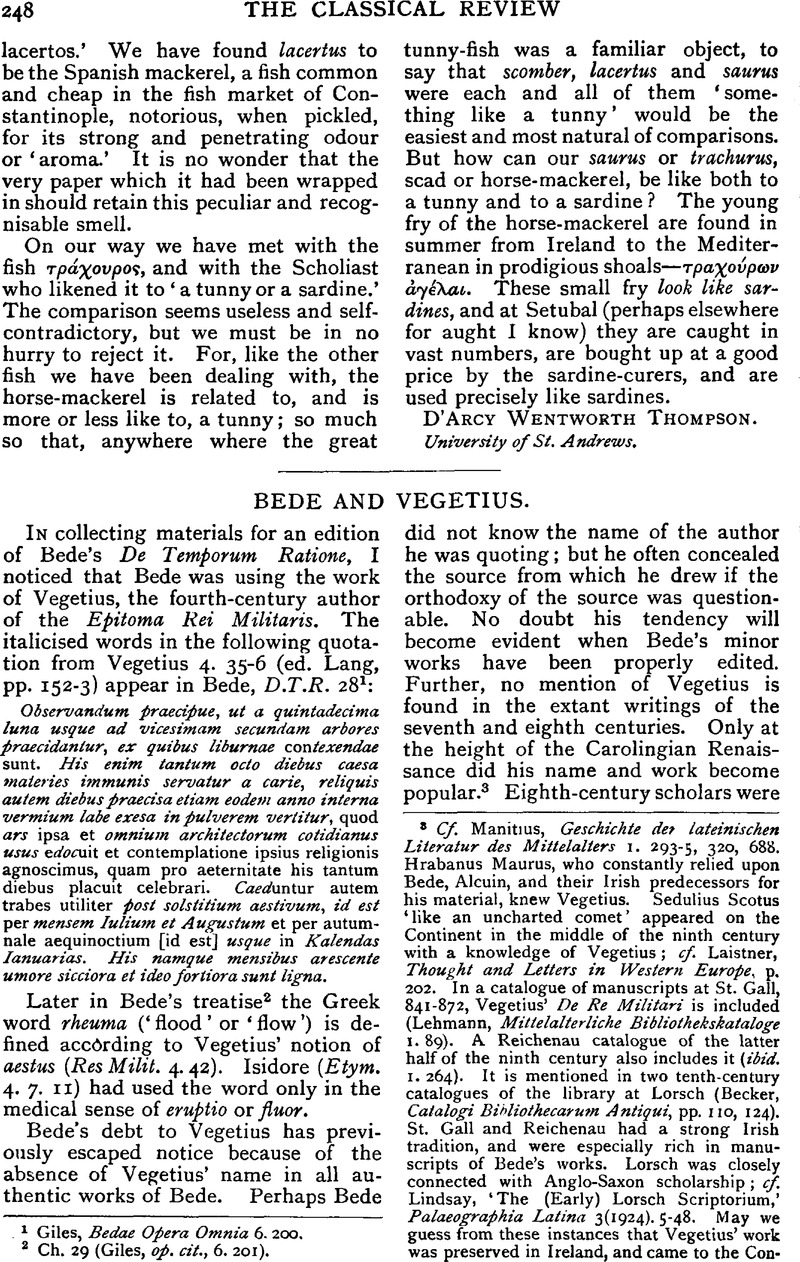Published online by Cambridge University Press: 27 October 2009

page 248 note 1 Giles, Bedae Opera Omnia 6. 200.
page 248 note 2 Ch. 29 (Giles, op. cit., 6. 201).
page 248 note 1 Cf. Manitius, , Geschichte der lateinischen Literatur des Mittelalters 1. 293–295, 320 688Google Scholar. Hrabanus Maurus, who constantly relied upon Bede, Alcuin, and their Irish predecessors for his material, knew Vegetius. Sedulius Scotus ‘like an uncharted comet’ appeared on the Continent in the middle of the ninth century with a knowledge of Vegetius; cf. Laistner, , Thought and Letters in Western Europe, p. 202Google Scholar. In a catalogue of manuscripts at St. Gall, 841–872, Vegetius' De Re Militari is included (Lehmann, , Mittelalterliche Bibliothekskataloge 1. 89)Google Scholar. A Reichenau catalogue of the latter half of the ninth century also includes it (ibid. 1. 264). It is mentioned in two tenth-century catalogues of the library at Lorsch (Becker, , Catalogi Bihliothecarum Antiqui, pp. no, 124)Google Scholar. St. Gall and Reichenau had a strong Irish tradition, and were especially rich in manuscripts of Bede's works. Lorsch was closely connected with Anglo-Saxon scholarship; cf. Lindsay, ‘The (Early) Lorsch Scriptorium,’ Palaeographia Latina 3(1924). 5–48. May we guess from these instances that Vegetius' work was preserved in Ireland, and came to the Continent with Irish or English scholars? All the extant manuscripts are too late to provide a basis for judgment; cf. Lang, , Vegetius, pp. xvi ff.Google Scholar
page 249 note 1 Giles, , Bedae Opera Omnia 12. 155Google Scholar. Professor M. L. W. Laistner has collated the following passage with rotographs of the MSS. Vatican Reg. Lat. 708 (Saec. Xiv ?) and Vatican Pal. Lat. 287 (Saec. Xii/xiii). In both manuscripts the Greek word is given in Latin letters (monoxillas and monoxylas). In Lang's text of Vegetius it is also in Latin letters (monoxylis).
page 249 note 2 Baedae Opera Historica 1. cxlvii.
page 249 note 3 Collingwood, R. G., ‘Hadrian's Wall: A History of the Problem,’ Journal of Roman Studies 11(1921). 46–47CrossRefGoogle Scholar. I retain Collingwood's italics.
page 249 note 4 Baedae Opera Historica 1. 16–7.
page 249 note 5 Christine de Pisan, The Fayttes of Armes and of Chyvalrye. Per Caxton. Compiled by Christine de Pisan from Vegetius, De Re Militari, etc. Translated by W. Caxton, July 14, 1489. Cf. Sayle, Cambridge University Library, Early Printed Books 1. 9.
According to MacCracken, (‘Vegetius in English,’ George Lyman Kittredge Anniversary Papers, p. 390), the first English translation of Vegetius was made in the year 1408: ‘It is remarkable, indeed, that the earliest known English translation should date from so late as 1408. The popularity of earlier French translations, still found in English libraries, may partly account for this delay.’Google Scholar